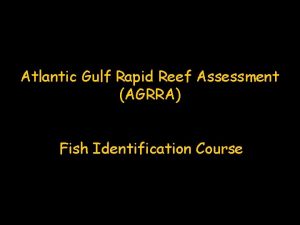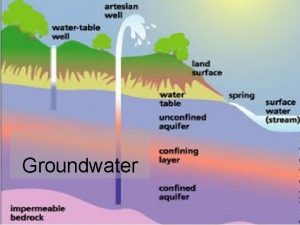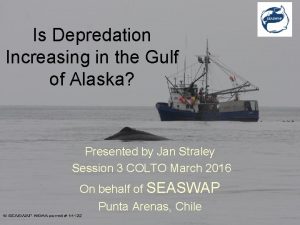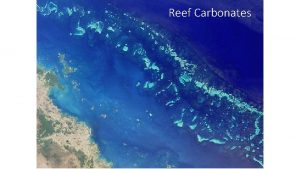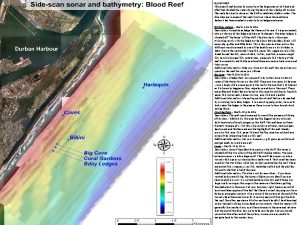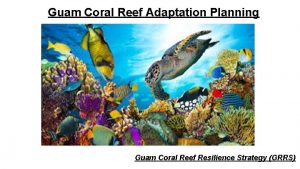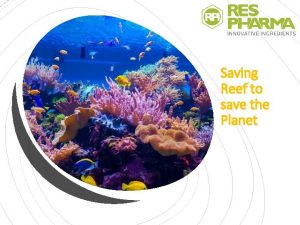Atlantic and Gulf Rapid Reef Assessment www agrra






































- Slides: 38

Atlantic and Gulf Rapid Reef Assessment www. agrra. org Reef Ecology Introduction University of Miami, RSMAS Dr. Robert Ginsburg

A healthy coral reef stony corals reef fishes crustose coralline algae © H. Moody

Stony corals have soft polyps above a stony (calcareous skeleton). © R. Mc. Call They expand to feed on plankton mostly at night. Meandrina meandrites

Colonies are formed when the polyps divide asexually. Tentacle Mouth Skeleton Colony Single Polyp Diagram from P. Humann

Large corals continue to grow via asexual division (reproduction) throughout their lives. Porites porites © K. Desai

Adult corals also reproduce sexually. Montastraea franksi Close-up Colpophyllia natans © G. P. Schmahl © E. Hickerson Species that grow large engage in mass spawning once, or several times, a year.

© R. Steneck Larvae that settle and become recruits often attach to crustose coralline algae. Recruits allow reefs to recover after disasters. Porites astreoides

Zooxanthellae (zooxs. )–tiny, yellow-brown algae inside the cells of stony reef corals. The zooxs. gain shelter, plus access to carbon dioxide and inorganic nutrients needed for photosynthesis. Close-up © J. Reichman Zooxs. photosynthesize and pass some organic molecules to coral host.

Bleaching occurs when polyps lose their yellowbrown colour. Bleached polyps are still alive. Close-up © L. Benvenuti Bleaching occurs because most of the “zooxs” are gone, and/or have lost their yellow-brown pigments. Porites

© R. Ginsburg Some bleached corals glow pale purple, pink or blue! Siderastrea siderea

Bleaching occurs in response to stressors like unusually high or low temperatures, high or low salinities, or too much sedimentation. © L. Benvenuti Mass bleaching when too warm during warm months. Montastraea faveolata

Corals are not killed by temporary bleaching. They will die if the stress lasts for an extended period of time, or is very severe. Bleaching events are occurring more often as the oceans warm. completely bleached partially bleached C. natans D. labyrinthiformis © S. Zea © L. Williams not bleached Montastraea

Pale–polyps that have either just started to bleach or are recovering from bleaching. Close-up pale Montastraea faveolata © P. Dustan bleached

Partial Mortality–when parts of a coral die, the white skeleton below is exposed. Close-up white skeleton = recent death live Mycetophyllia © P. Dustan

When coral polyps have just been killed, the freshly exposed, white skeleton may look bleached. turf algae recently dead © J. Lang live Colpophyllia natans

Bleached, not dead– Polyps are translucent (nearly colorless) and distort the appearance of the skeleton below. Close-up © J. Lang Corals with large, thick polyps are conspicuous, even when they are bleached. Montastraea cavernosa

After they have bleached, small, thin polyps are hard to see. Close-up Partially bleached Montastraea faveolata © E. Peters Sometimes a fluorescent rim (not present here) is visible around the mouths of M. annularis, M. faveolata, and M. franksi.

What else kills stony corals? Pathogens © L. Benveuti Outbreaks of disease have also increased in frequency and severity in recent decades. Montastraea cavernosa

Black-Band Disease A discrete, dark reddish-brown or black mat at the interface between live polyps and recently exposed coral skeleton. Close-up © P. Dustan Don’t confuse the exposed skeleton with bleaching! Montastrara faveolata

What’s going on here? © L. Benvenuti Bleaching + recent death from black-band disease Colpophyllia natans

Yellow-band (blotch) Disease Tissues are pale (even bleached) before dying. Mostly in Montastraea and brain corals. later stage; algal turfs in dead area © A. Bruckner early stage; no dead polyps Montastraea faveolata

More advanced stage Montastraea faveolata © J. Lang Close-up, early stage © E. Peters Because the polyps initially are pale, yellow-band disease is easily confused with bleaching, especially in the early stages of the disease.

Yellow-band Disease Coral polyps may die so slowly that recently exposed, white skeleton is rarely seen. Montastraea faveolata © R. Ginsburg A colorlessyellow rim develops along the margins of the live polyps

White plague No “band” at the interface between polyps and recently dead skeleton. Polyps die relatively quickly. Most common in head © P. Dustan © G. Schmahl, FKNMS corals. Close-up Colpophyllia natans Dichocoenia stokesi

White plague outbreaks occurred after the mass bleaching events in 1998 and 2005. . BVI, Jan. 2006 Montastraea faveolata © C. Aldridge

Dark Spots Disease © A. Bruckner Blotchy discolorations. Polyps die slowly, or sometimes recover. Most common in S. siderea and S. intersepta. Siderastrea siderea Stephanocoenia intersepta

Corallivores (coral predators) Some fishes and invertebrates eat stony corals. parrotfish bites Montastraea annularis © B. Kakuk damselfish algal gardens Montastraea faveolata Corallivore densities can be extremely high if their own predators are overfished.

spot bites in a Montastraea Close-up deep bites at the edge of a C. natans © A. Bruckner Stoplight (Sparisoma viride) and certain other parrotfishes bite or scrape coral polyps, removing the underlying skeleton.

Montastraea annularis © A. Bruckner Parrotfish bites sometimes merge to form huge lesions that can be over 25 cm long on M. annularis lobes. stoplight parrotfish (Sparisoma viride) biting Montastraea annularis

Damselfish Bites Stegastes planifrons (threespot damselfish) © B. Kakuk © P. Humann Small, circular (<1 cm diameter) lesions in live coral are created by threespots and some other damselfish bites in Montastraea

Damselfish Algal Gardens The damselfish cultivate tiny algal turfs that settle on the exposed skeletons for food and shelter for their offspring. Montastraea annularis © J. Lang © B. Kakuk Close-up Porites astreoides

Predation–Hermodice carunculata Scars on branch tips or small bumps on head corals. Usually feed at night. H. carunculata on A. palmata WP H. carunculata on M. ? faveolata with white plague © A. Bruckner Close-up © P. Dustan feeding scar

Macroalgae (Seaweeds)/Algal Turfs Sea weeds and algal turfs are kinds of benthic algae that can compete with corals for space on the bottom. © B. Kakuk

© M. Moe Diadema antillarum (black sea urchin) © R. Steneck Black sea urchins and herbivorous fishes grow large enough to dislodge seaweeds. Sparisome viride (stoplight parrotfish)

© B. Causey Dying Diadema, 1983 Black sea urchin populations have not yet fully recovered.

1960’s 1990’s © M. J. Hugenholtz © C. van Dongen Overfishing spearing

Overfishing small mesh traps 2000’s 1990’s

© J. Bruno On reefs with few large herbivores, seaweeds or algal turfs are now overgrowing stony corals and preventing larval settlement.
 Siklus interaksi
Siklus interaksi Agrra
Agrra Agrra
Agrra Lamanya pelaksanaan rapid health assessment
Lamanya pelaksanaan rapid health assessment Lexia rapid test
Lexia rapid test Rapid ethnographic assessment
Rapid ethnographic assessment Sarc f
Sarc f Rula score sheet
Rula score sheet Rapid environmental impact assessment in disaster
Rapid environmental impact assessment in disaster Oak woods and prairies climate
Oak woods and prairies climate Piney woods characteristics
Piney woods characteristics Gulf of execution and evaluation examples
Gulf of execution and evaluation examples South texas plains weathering
South texas plains weathering Gulf bond and sukuk association
Gulf bond and sukuk association Southeastern and gulf cultures
Southeastern and gulf cultures Gulf of execution and evaluation
Gulf of execution and evaluation Al reef institute of logistics and applied technology
Al reef institute of logistics and applied technology Gulf coast community services
Gulf coast community services How does weathering impact the edwards plateau ecoregion?
How does weathering impact the edwards plateau ecoregion? Weathering in cross timbers
Weathering in cross timbers Kanarya soğuk su akıntısı
Kanarya soğuk su akıntısı Gulf of mexico history
Gulf of mexico history Gulf coast odyssey of the mind
Gulf coast odyssey of the mind Mobile crisis outreach team houston
Mobile crisis outreach team houston Gulf coast aquifer
Gulf coast aquifer Entergy ruston la
Entergy ruston la Gulf logo quiz
Gulf logo quiz Western gulf culture
Western gulf culture Western gulf culture
Western gulf culture Spe code of ethics
Spe code of ethics Downwelling
Downwelling Nuweiba beach chariots
Nuweiba beach chariots Gulf of alska
Gulf of alska Goodcents menu
Goodcents menu Coastal region of texas
Coastal region of texas Red sea crossing map
Red sea crossing map Post oak belt climate
Post oak belt climate 4 texas regions
4 texas regions North central plains
North central plains

